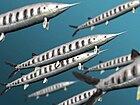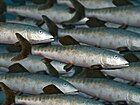
Osteoglossidae is a family of large-sized freshwater fish, which includes the arowanas and arapaima. They are commonly known as bonytongues. The family contains two extant subfamilies Arapaiminae and Osteoglossinae, with a total of five living genera. The extinct Phareodontinae are known from worldwide during the Late Cretaceous and Paleogene; they are generally considered to be crown group osteoglossids that are more closely related to one of the extant osteoglossid subfamilies than the other, though their exact position varies.

Canobius is an extinct genus of early marine ray-finned fish that lived in the early Carboniferous period (Viséan) of Glencartholm, Scotland.

Protosphyraena is a fossil genus of swordfish-like marine fish, that thrived worldwide during the Cretaceous period (Albian-Maastrichtian). Fossil remains of this taxon are mainly discovered in North America and Europe, and potential specimens are also known from Asia, Africa and Australia. Its fossils are best known from the Smoky Hill Member of the Niobrara Chalk Formation of Kansas.

Palorchestes is an extinct genus of large terrestrial, herbivorous Australian marsupial of the family Palorchestidae, living from the Miocene through to the Late Pleistocene. Like other palorchestids, it had highly retracted nasal region suggesting that it had a prehensile lip, as well as highly unusual clawed forelimbs that were used to grasp vegetation.
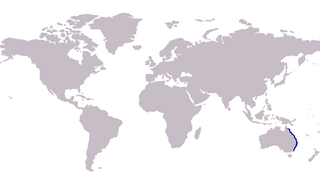
The trumpeter whiting, also known as the winter whiting or diver whiting, is a common species of coastal marine fish of the smelt-whiting family, Sillaginidae. The trumpeter whiting is endemic to Australia, inhabiting the eastern seaboard from southern New South Wales to northern Queensland. The species is found in bays, estuaries, coastal lakes and mangrove creeks on silty and muddy substrates in waters ranging from 0 to 30 m deep, occasionally inhabiting sandy and seagrass beds.
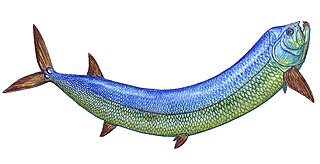
Cooyoo is an extinct genus of ichthyodectid fish known from the Lower Cretaceous. It contains a single species, C. australis, known from the Albian-aged Toolebuc and Allaru Formations of Queensland, Australia. C. australis was originally named by Arthur Smith Woodward as a species of Portheus in 1894, which was later amended to Xiphactinus.
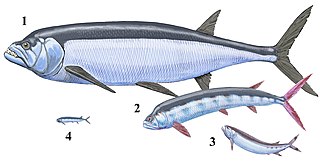
Ichthyodectiformes is an extinct order of marine stem-teleost ray-finned fish. The order is named after the genus Ichthyodectes, established by Edward Drinker Cope in 1870. Ichthyodectiforms are usually considered to be some of the closest relatives of the teleost crown group.
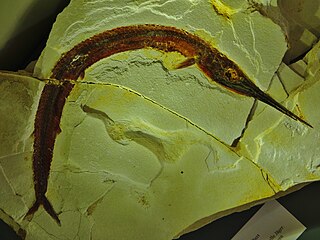
Belonostomus is a genus of prehistoric ray-finned fish that was described by Louis Agassiz in 1844. It is a member of the order Aspidorhynchiformes, a group of fish known for their distinctive elongated rostrums.

Aspidorhynchidae is an extinct family of ray-finned fish from the Mesozoic Era. It is the only member of the monotypic order Aspidorhynchiformes. Members of the group are noted for their elongated, conical rostrums, of varying length, formed from fused premaxillae. The range of the group extends from the Middle Jurassic to the end of the Maastrichtian, with a potential record from the Late Paleocene. The family and order were described by Pieter Bleeker in 1859.

Caranx is a genus of tropical to subtropical marine fishes in the jack family Carangidae, commonly known as jacks, trevallies and kingfishes. They are moderate- to large-sized, deep-bodied fishes which are distinguished from other carangid genera by specific gill raker, fin ray and dentition characteristics. The genus is represented in the Pacific, Indian and Atlantic Oceans, inhabiting both inshore and offshore regions, ranging from estuaries and bays to deep reefs and offshore islands. All species are powerful predators, taking a variety of fish, crustaceans and cephalopods, while they in turn are prey to larger pelagic fishes and sharks. A number of fish in the genus have a reputation as powerful gamefish and are highly sought by anglers. They often make up high amounts of the catch in various fisheries, but are generally considered poor to fair table fishes.
The Toolebuc Formation is a geological formation that extends from Queensland across South Australia and the Northern Territory in Australia, whose strata date back to the Albian stage of the Early Cretaceous. Dinosaurs, pterosaurs, plesiosaurs, ichthyosaurs, protostegid turtles, sharks, chimaeroids and bony fish remains are among the fossils that have been recovered from the formation.
The Allaru Formation, also known as the Allaru Mudstone, is a geological formation in Queensland, Australia, whose strata date back to the Early Cretaceous. Dinosaur remains are among the fossils that have been recovered from the formation.
Cladocyclus is an extinct genus of marine ichthyodectiform fish from the middle Cretaceous. It was a predatory fish of about 1.20 metres (3.9 ft) in length.

Araripichthys is an extinct genus of marine ray-finned fish that lived from the Aptian to Coniacian stages of the Cretaceous period. The genus is named after the Araripe Basin, where it was found in the Crato and Santana Formations. Other fossils of the genus have been found at Goulmima in Morocco, the Tlayua Formation of Mexico and the Apón Formation of Venezuela.
Flindersichthys is an extinct genus of prehistoric bony fish that lived during the Albian stage of the Early Cretaceous epoch.
Aphnelepis is an extinct genus of prehistoric freshwater ray-finned fish that lived during the Late Jurassic epoch. It contains a single species, A. australis, from the Talbragar River beds of New South Wales, Australia.
Aetheolepis is an extinct genus of ray-finned fish which lived in freshwater environments in what is now Western Australia and New South Wales during the Jurassic period. It contains one species, A. mirabilis. Aetheolepis was previously thought to be an archaeomaenid, until a 2016 study instead recovered it as a member of the family Dapediidae. Like other dapediids, it had a deep, discoid-shaped body. Fossils of A. mirabilis have been found in the Talbragar River fossil beds of New South Wales and the Colalura Sandstone of Western Australia. It was named by Arthur Smith Woodward in 1865 along with other Talbragar fish.

Anaethalion is an extinct genus of prehistoric marine and freshwater ray-finned fish related to modern tarpons and ladyfish. It is known from the Late Jurassic to the Early Cretaceous of Europe and northeasterrn Asia, roughly encompassing the Tethys Ocean.
Alan Bartholomai AM (1938–2015) was a geologist and palaeontologist, and Director of the Queensland Museum from 1969–1999.

Etelis carbunculus, the deep-water red snapper, ruby snapper, longtail snapper, or ehu, is a species of ray-finned fish, a snapper belonging to the family Lutjanidae. It is found in the Indo-Pacific region.














